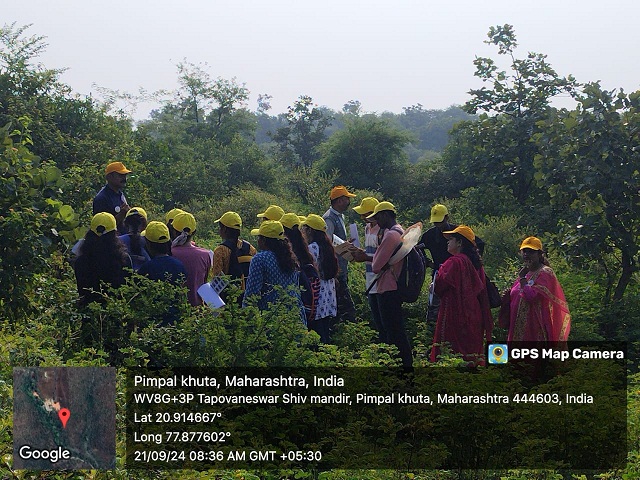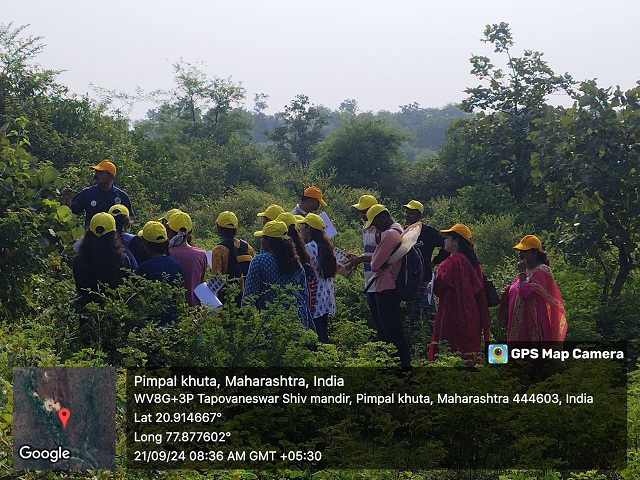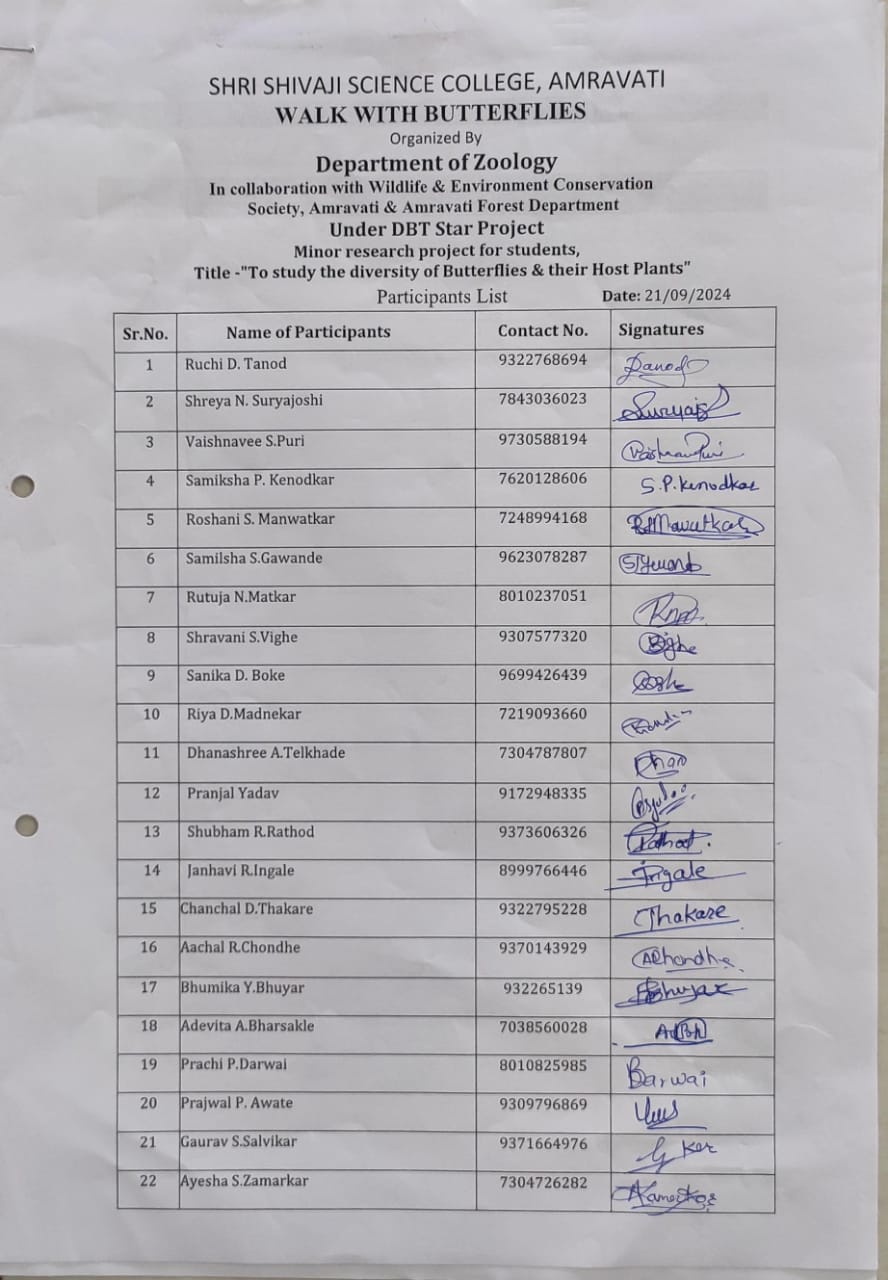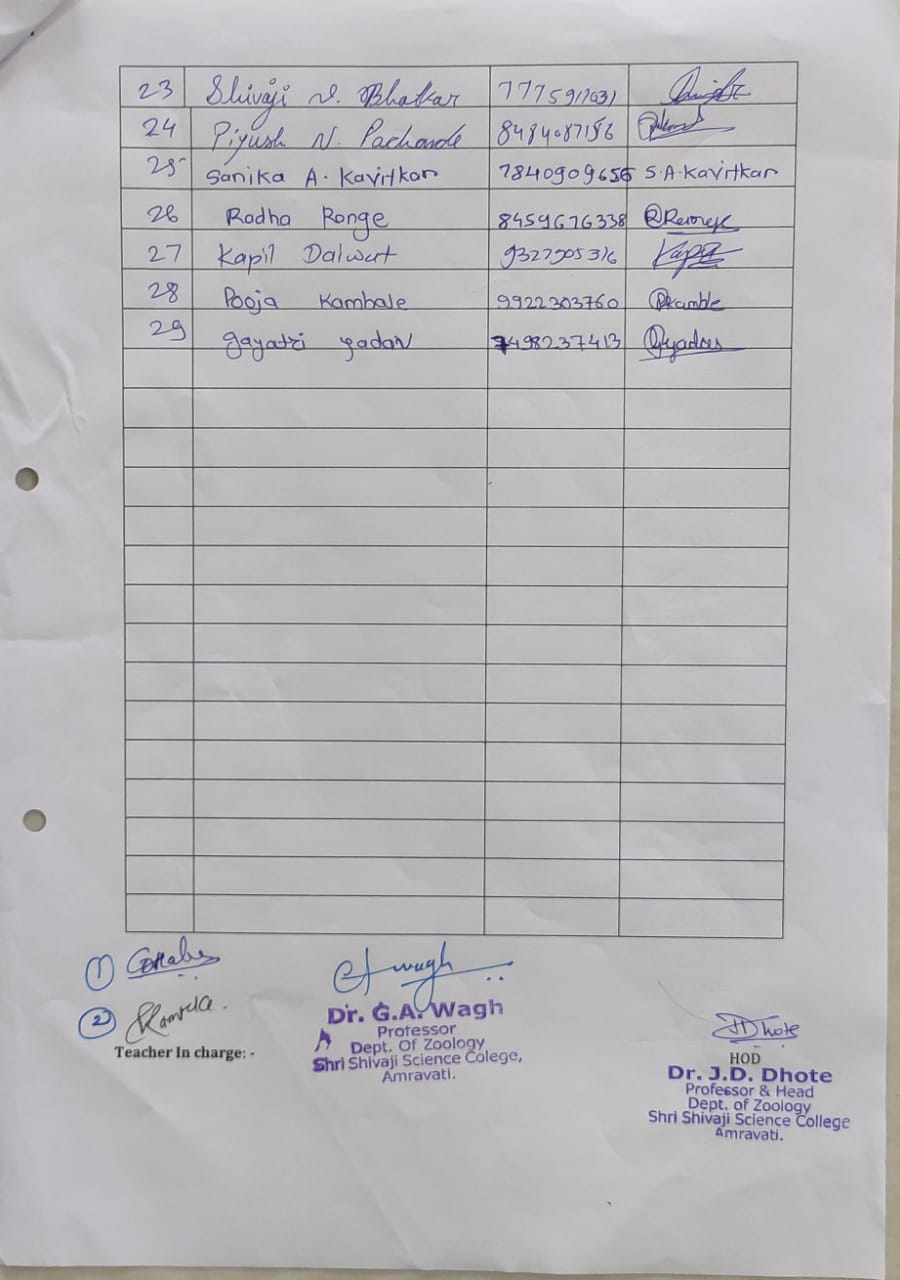SHRI SHIVAJI SCIENCE COLLEGE, AMRAVATI
DBT STAR COLLEGE PROJECT ACTIVITY
ACTIVITY REPORT

To Study the diversity of Butterflies and their Host Plants
Activity Dates: 21/09/2024
Type of Activity: Minor Research Project
Organizing Department: Department of Zoology
Program Coordinators: Dr.Gajanan A.Wagh
Head of the Department: Dr.J.D.Dhote
External Collaborator (if any): Wildlife & Environment Conservation Society, Amravati & Amravati Forest Division
Objectives:
- To study the diversity of butterflies
- To study the host plant of butterflies
- To study the butterfly life cycle
- To study the butterfly behavior
- To prepare the checklist of Butterflies of Pohara-Malkhed reserve Forest
No of Beneficieries: 29
Classes Involved: Students of B.Sc.III (BIO)
Venue of the Activity: Tapowaneswar area,Pohara-Malkhed reserve Forest,Amravati
Activity Report:
SHRI SHIVAJI SCIENCE COLLEGE, AMRAVATI
Department of Zoology
Organized
WALK WITH BUTTERFLIES
21 September 2024
(Big Butterfly Month)
In collaboration with Wildlife & Environment Conservation
Society, Amravati & Amravati Forest Division
Under DBT Star Project scheme
Student Activity –Minor Research project for B.Sc. III students
Title of the Project
To Study the diversity of Butterflies and their Host Plants
Aims and Objectives of the project:
1. To study the diversity of butterflies
2. To study the host plant of butterflies
3. To study the butterfly life cycle
4. To study the butterfly behavior
5.To prepare the checklist of Butterflies of Pohara-Malkhed reserve Forest
Target Group: B.Sc.III (Bio) students
No. of beneficiaries: 29 students of B.Sc.III (BIO)
Activity Report:
‘Walk with butterflies program’ organized by Department of Zoology, Shri Shivaji Science College, Amravati in collaboration with Wildlife & Environment Conservation Society, Amravati and Amravati Forest Division, Under DBT Star Project scheme- 2024 as a part of minor research project survey in Pohara-Malked Reserve forest, Amravati.
Counting butterflies is extremely important not just because we love them and they are beautiful creatures but due to the intricate role they play in the ecosystem as components of the food chain as well as being pollinators. Butterflies are under severe threat, like all wildlife around us their numbers have also sharply declined and these signs can no longer be ignored. The butterfly population in India is threatened by habitat loss and degradation. Here are some of the factors that are affecting the butterfly population in India like habitat loss, and more use of insecticides and weedicides by farmers.
Butterflies are also key biodiversity indicators for scientists as they are very sensitive to changes in the environment. That is why the project comes in, tracking these numbers is crucial in our fight to conserve our natural world and life on it.
In all 29 students from BSc III(BIO) were participated in field survey in Pohara-Malkhed Reserve forest, Amravati as a part of research project entitled “To Study the diversity of Butterflies and their Host Plants”. During survey students recorded 40 butterfly species. Also they observed the eggs and caterpillars of lime butterflies with their host plants. Total 22 host plants of butterfly were enlisted during survey. Out of 40 butterfly species,12 were LC,25 NE and 03 species of Butterflies were come under schedule –II category.
Habitat loss, grazing, used of pesticides and weedicides were observed as a major threats to the butterfly diversity in study area.
The survey was carried out by department of Zoology in the presence of Butterfly expert Dr. Jayant Wadatkar Amravati, Dr.J.D.Dhote Professor and head, Department of Zoology, Dr. G.A.Wagh DBT Project coordinator of Zoology Department and Dr.G.D.Hande & Dr.P.M.Ramteke in-charge teachers.
This field survey aimed was to document the diversity of butterflies, to observe the different stages of butterfly lifecycle and their activities and also to study the host plants of butterflies.
Material prepared for Students:
1) Information brochure on Butterflies
2) Butterfly batch
3) Cap with butterfly logo
4) Cards for life cycle study.
List of Butterflies of Pohara-Malked Reserve Forest,Amravati
Sr. No. Common Name Scientific Name Status IUCN status WPA 2022 schedule
1 Common Crow Euploea core C NE -
2 Common Gull Cepora nerissa C NE -
3 Common leopard Phalanta phalantha C LC -
4 Common Jezeble Delias eucharis C NE -
5 Lemon Pansy Junonia lemonias C LC -
6 Blue pansy Junonia orithiya C LC -
7 Chocolate pansy Precis iphita UC NE -
8 Yellow pansy Junonia hierta UC LC -
9 Peacock pansy Junonia almana C LC -
10 Grey pansy Junonia atlites UC LC -
11 Baronet Euthalia nais C NE -
12 Angled caster Ariadne ariadne C NE -
13 Common Emigrant Catopsilia Pomona C NE -
14 Stripea Albatrous Appias libythea UC NE -
15 Motteled Emigrant Catopsilia pyranthe Linnaeus C NE -
16 Twany Coster Acraea violae C NE -
17 Danaid eggfly Hypolimnas misippus UC LC II
18 Crimson Rose Pachiopta hactor UC LC II
19 Common Rose Pachiopta aristolochiae C LC -
20 Common Mormon Papillio polytes C NE -
21 Joker Byblia ilithyia C NE -
22 Great Eggfly Hypolimnas bolina UC NE -
23 Indigo flash Rapala varuna R NE II
24 Tailed J Graphium Agamemnon R NE -
25 Common shot Spindasis ictis R NE -
26 Common Evening Brown Brown(Melanitis leda C LC -
27 Dark Evening Brown Melantis phedima C NE -
28 Common Grass Yellow Eurema Hecabe Linnaeus C LC -
29 One spot grass yellow Eurema andersoni Moore C NE -
30 Three spot Grass yellow Eurema blanda C NE -
31 Plain Tiger Danaus chrysippus C LC -
32 Blue Tiger Tirumala limniace C NE -
33 Lime Butterfly Papailio demoleus C NE -
34 Rounded Pierrot Tarucus nara UC NE -
35 Zebra Blue Leptotes plinius C NE -
36 Dark Glass blue Zizeerai karsandra C NE -
37 Lime Blue Chilades laius C NE -
38 Gram Blue Euchrysops cnejus C NE -
39 Crimson Tip Calotis danae R NE -
40 Little orange tip Calotis etrida etrida R NE -
C=common, UC=uncommon and R= Rare; LC=least concern, NE= Not evaluated; Schedule I & II as per Wildlife protection amendment Act,1972.
List of host plants of Butterfly
Sr. No Scientific name of the host plants Preferred by Butterfly species
1 Aristolochia littoralis Crimson Rose
2 Paraclyx scariosa Gram Blue
3 Annona squamosa Lime Butterfly
4 Capparis zeylanica Little orange tip
5 Butea monosperma Common Grass Yellow
6 Cassia tora Common Grass Yellow
7 Albizia lebbek Common Mormon
8 Evolvilus alsinoidea Lime Butterfly
9 Calotropis procera Plain Tiger
10 Muncuna pruriens Joker
11 Ricinus communis Angled caster
12 Zizipus species Zebra Blue
13 Lantana camara Common Jezeble
14 Bauhinia recemosa Common Crow
15 Citrus species Lime Butterfly
16 Ficus bengalensis Common Crow
17 Ficus recemosa Common Crow
18 Ficus religiosa Common Crow
19 Aegle marmelos Lime Butterfly
20 Corchorus olitorius Lemon Pansy
21 Cassia fistula Common Emigrant
22 Tridax procumbens Twany Coster
Significant outcomes of the Project:
1. Checklist of Butterflies of Pohara –Malkhed Forest
2. Documentation of Butterfly species with their host plants
3. Known the behavior & flight of Butterflies pattern
4. Observed the mud puddling behavior of butterflies
5. Known the life cycle of lime butterfly.
Outcomes:
- Checklist of Butterflies of Pohara –Malkhed Forest
- Documentation of Butterfly species with their host plants
- Known the behavior & flight of Butterflies pattern
- Observed the mud puddling behavior of butterflies
- Known the life cycle of lime butterfly.
Photos:
 Students identifying the butterfly species with the help of prepared butterfly leaflet |  Students observing butterfly species on field |
 Project students with students in walk with butterfly program |  Students observing the butterfly behavior |
 Experts guiding the students on field during survey |  Students observing the butterfly and host plant relationship |
Attendance Sheet:
 |
 |